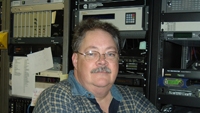KXII transmits two HD, one SD channel in 6MHz

KXII in Sherman, TX, recently became what may be the first station in the United States to transmit two HD channels and one SD channel in its 6MHz digital channel.
The station transmits both the 1080i CBS and 720p Fox networks in HD, and its MyNetwork station, branded as “MyTexoma,” in SD using encoders, statistical multiplexing equipment and software from Harmonic.
HD Technology Update spoke with station chief engineer Randy Wells to find out the details and learn how successful the station has been in transmitting two HD and one SD channel in 19.4Mb/s.
HD Technology Update: What is the background on the decision to broadcast two HD streams and one SD? What pushed you to do it — the impending 2009 deadline, market penetration of HD sets, the technological feasibility?
Randy Wells: One of the driving factors was that our corporate ownership had made the move to expand the number of channels in our digital stream. The technology was becoming available, and as we saw the HD marketplace grow, we wanted to stay ahead of the curve.
HDTU: Were you surprised that two HD streams of MPEG-2 video and one SD could fit in a 6MHz (19.4Mb/s) channel?
RW: I was pleasantly surprised, shall we say. I had already attempted one HD and two SD’s in one 6MHz stream using our Harris Flexcoder, so I knew it was doable with that, and it required stat muxing to do it well. When Harmonic came on the scene with their products and said they could do two HD and a standard def, and proved it at NAB, we decided to go in that direction.
Get the TV Tech Newsletter
The professional video industry's #1 source for news, trends and product and tech information. Sign up below.
HDTU: Could you describe how the Harmonic system, which includes DiviCom MB 500 HD encoder, MV 100 MPEG-2 SD encoder, DiviTrack statistical multiplexing and NMX Digital Service Manager, is being used?
RW: They all work together as a team. I know that the multiplexer is constantly talking back to the encoders through ASI cabling, and the NMX program at the end is keeping everything under control. It works pretty well.
HDTU: Will you always use statistical multiplexing for the two HD and one SD channel? Could you foresee a circumstance where you would want to devote more bandwidth to a given channel — perhaps for a special event like the Super Bowl?
RW: Yes, there are times when we may want to give and take on those channels depending upon things like the Super Bowl or other sporting events. We would hope to be able to fine-tune or tweak the stat muxing. That is always available within the NMX control.
HDTU: How would you go about doing that?
RW: We have a rather generous amount now for our two HDs, and when I say generous, we have a range for CBS of 5Mb/s to 15Mb/s and for Fox from 4Mb/s to 14Mb/s, and the standard def, I think, is probably 1 to 5 or 6Mb/s. So, at any one time, any of the channels has the ability to take advantage of that, but during most of programming things are riding along there with the high def usually at 7 to 10Mb/s, maybe 11Mb/s. In times when say it was the Super Bowl on Fox, we would probably give it a bit more and pull CBS back some, and our standard def if there was no game on that, we could trim a little bit there, but not much more. We’re running pretty lean on it as it is.
HDTU: To your knowledge, do network affiliates have an obligation to their network partner to devote a certain amount of bandwidth to broadcast their HD stream?
RW: I'm not 100 percent certain about that. Again, that's a management call. I'm not sure that we are contractually obligated. I think it has been broached before. It has been brought up by other people, but there's never been any further discussion of it.
HDTU: How does it look?
RW: It looks good. I was watching our CBS Monday night — “CSI Miami” — and it just looks beautiful.
HDTU: When did you go on air with the two HD and one SD channel in your single 19.4Mb/s stream?
RW: We went on air sometime in late April. It was before the May sweeps, so it’s almost six months. Since we first put it on air, there have been some firmware releases for the encoders, and we wanted to get those in place. Harmonic is good about improving their product on a regular basis with firmware upgrades that squeeze out a little bit more bandwidth each time. So they've been good about that, and we wanted to give ourselves enough time because this was new for us, and we wanted to give it enough time to develop.
HDTU: According to Harmonic, you are the first station on the air with two HD channels and one SD channel in the same ATSC stream.
RW: I believe we are.
HDTU: Did the station face any unexpected issues when rolling out the two HD and one SD channel?
RW: No, I can’t think of any as far as the technical side of our operation that we encountered, other than having to add some interface equipment.
HDTU: Is there anything else you would like to add?
RW: Nothing that I can think of. That’s the nice thing about it. When it just sits back there and works, and works dependably, then there's not a whole lot to say other than it’s working and working well.
Tell us what you think!
HDTU invites response from our readers. Please submit your comments to editor@broadcastengineering.com. We'll follow up with your comments in an upcoming issue.
